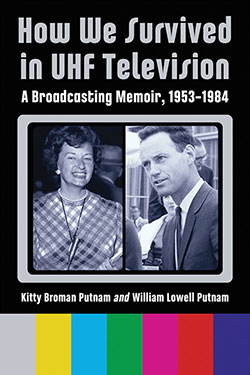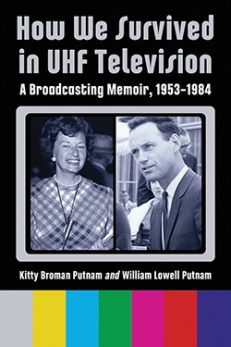How We Survived in UHF Television
A Broadcasting Memoir, 1953–1984
$25.00
In stock
About the Book
This personal narrative is co-authored by two of the best-known names in American UHF television broadcast management: Kathryn “Kitty” Broman Putnam and William Lowell “Bill” Putnam. During the first two decades of Ultra-High Frequency (UHF) television, when the established VHF (Very-High Frequency) stations dominated the TV marketplace, the Putnams built and operated three successful UHF outlets: WWLP-TV in Springfield, Massachusetts; WKEF-TV in Dayton, Ohio; and KSTU-TV in Salt Lake City, Utah.
Kitty and Bill recall how they labored for survival during the “dozen lean years” between 1952 and 1964, and the events along their way to leadership in the world of advertiser-supported analog television. Included are several original poems written by Bill, and tantalizing recipes created for Kitty’s long-running local cooking show.
About the Author(s)
Bibliographic Details
Kitty Broman Putnam and William Lowell Putnam
Format: softcover (6 x 9)
Pages: 242
Bibliographic Info: 80 photos, appendices, index
Copyright Date: 2012
pISBN: 978-0-7864-6666-5
eISBN: 978-0-7864-8809-4
Imprint: McFarland
Table of Contents
Authors’ Note 1
Preface 3
1. Getting Started in Television 9
2. Actually Building a Station 21
3. Lowering Our Frequency—Overnight 36
4. Parentheses 40
5. Building a Local Audience 50
6. Those Magnificent Irishmen 89
7. Building a Network Relationship 102
8. Building Advertiser Support 123
9. Not All Hard Work—Boys Will Be Boys 130
10. Onto the National Scene 144
11. Editorials in the “Fairness” Era 152
12. Dealing with the FCC 161
13. Building the Broadcast Industry—Kitty’s Station 178
14. Glimpsing the Future 194
15. Personalities 199
16. A Poetic Heritage Comes Out 203
Appendix A 217
Appendix B 224
Index 231





